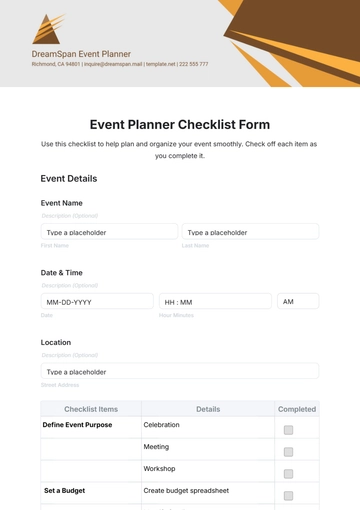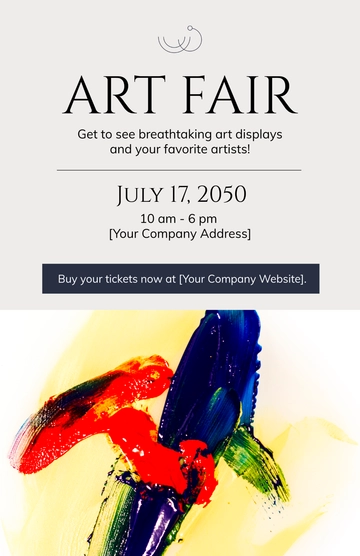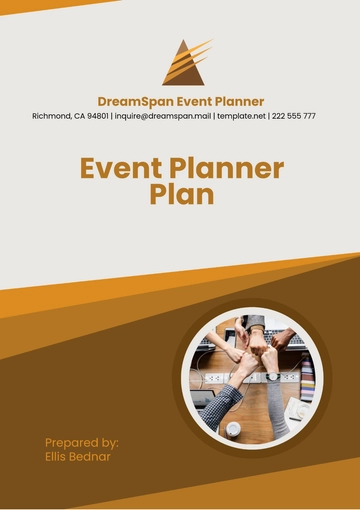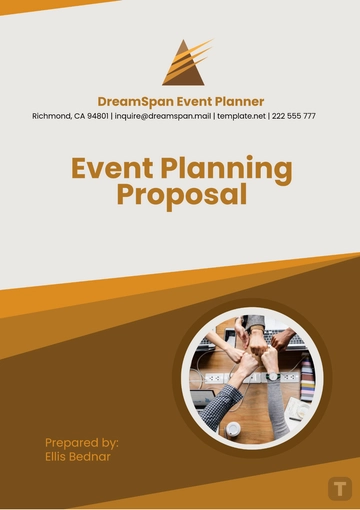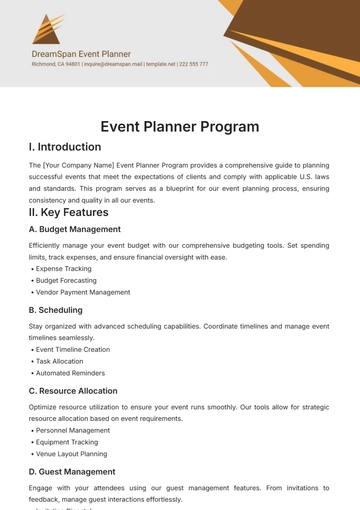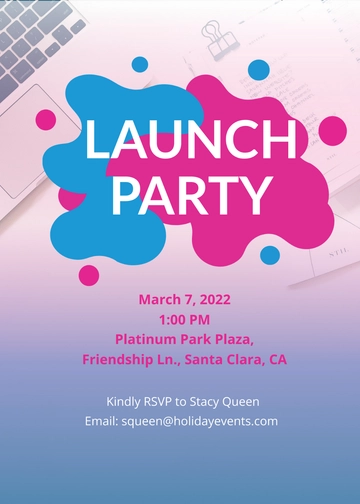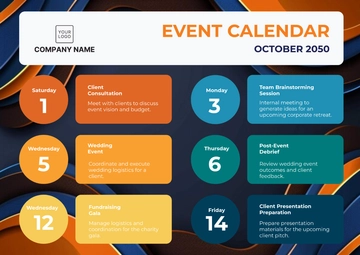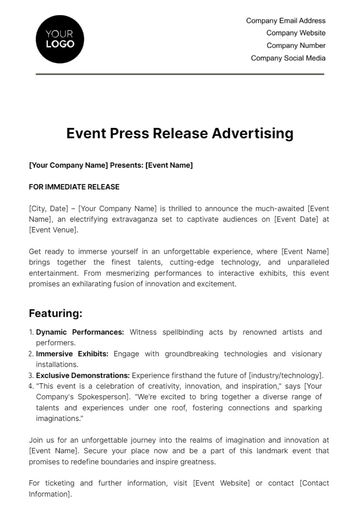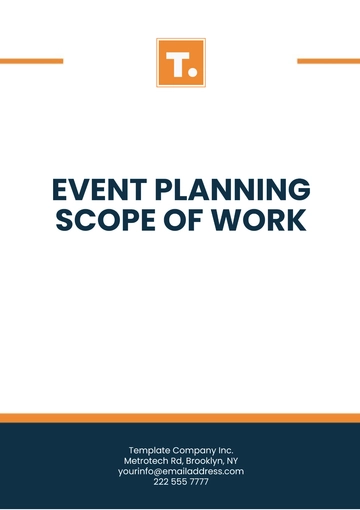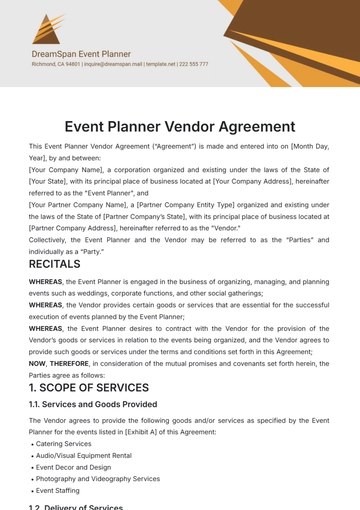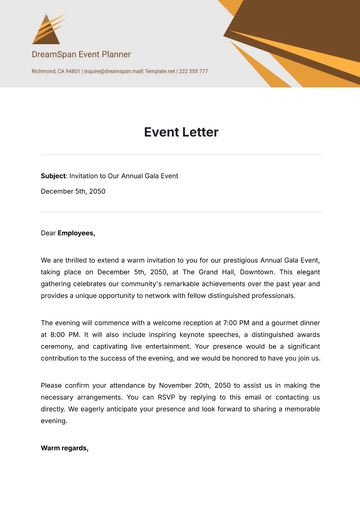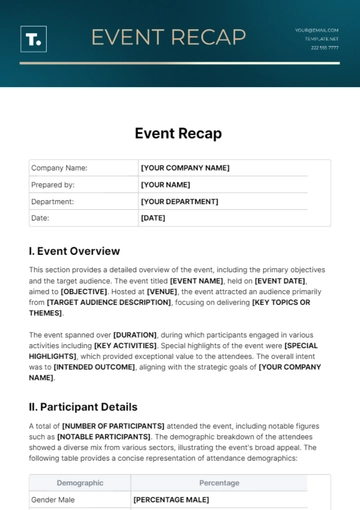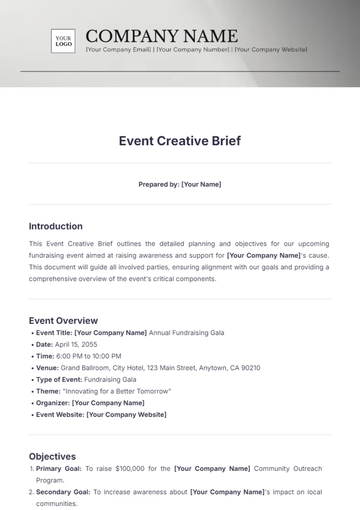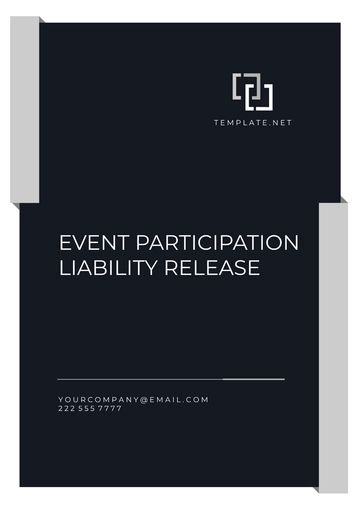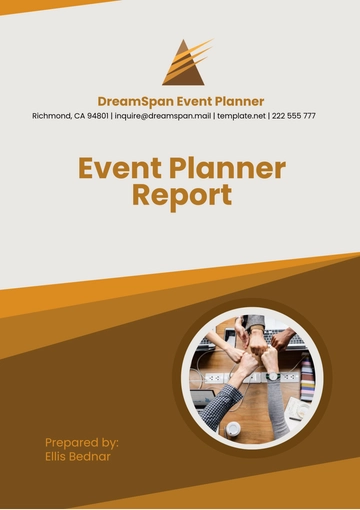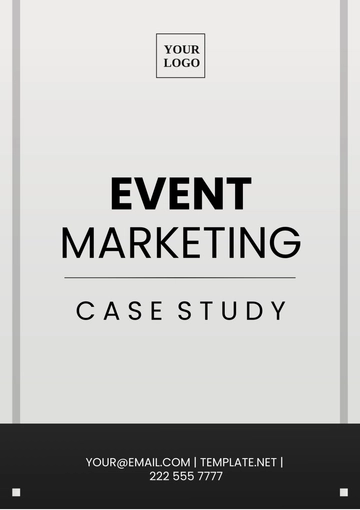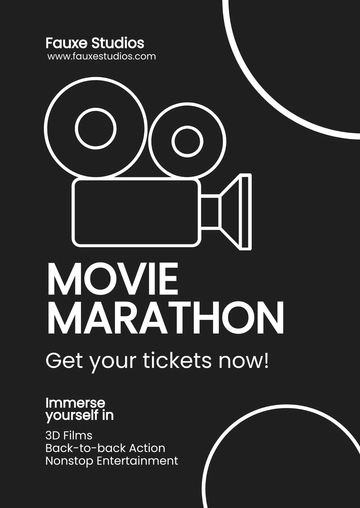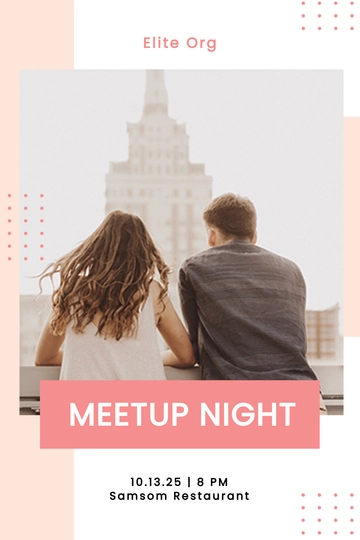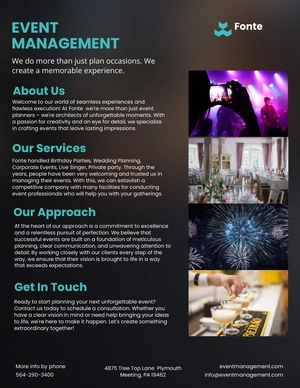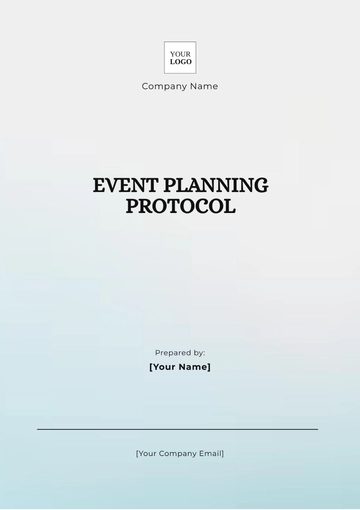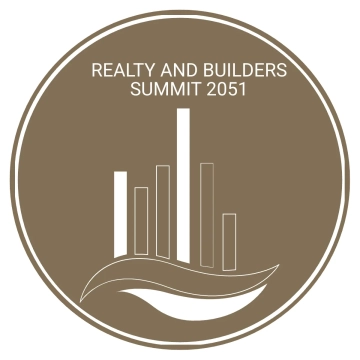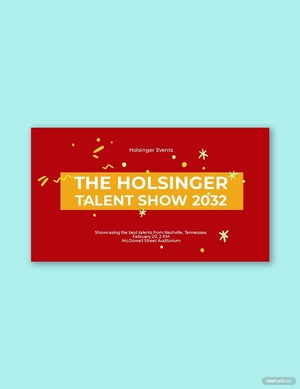Free Event Management and Publicity Advertising Playbook
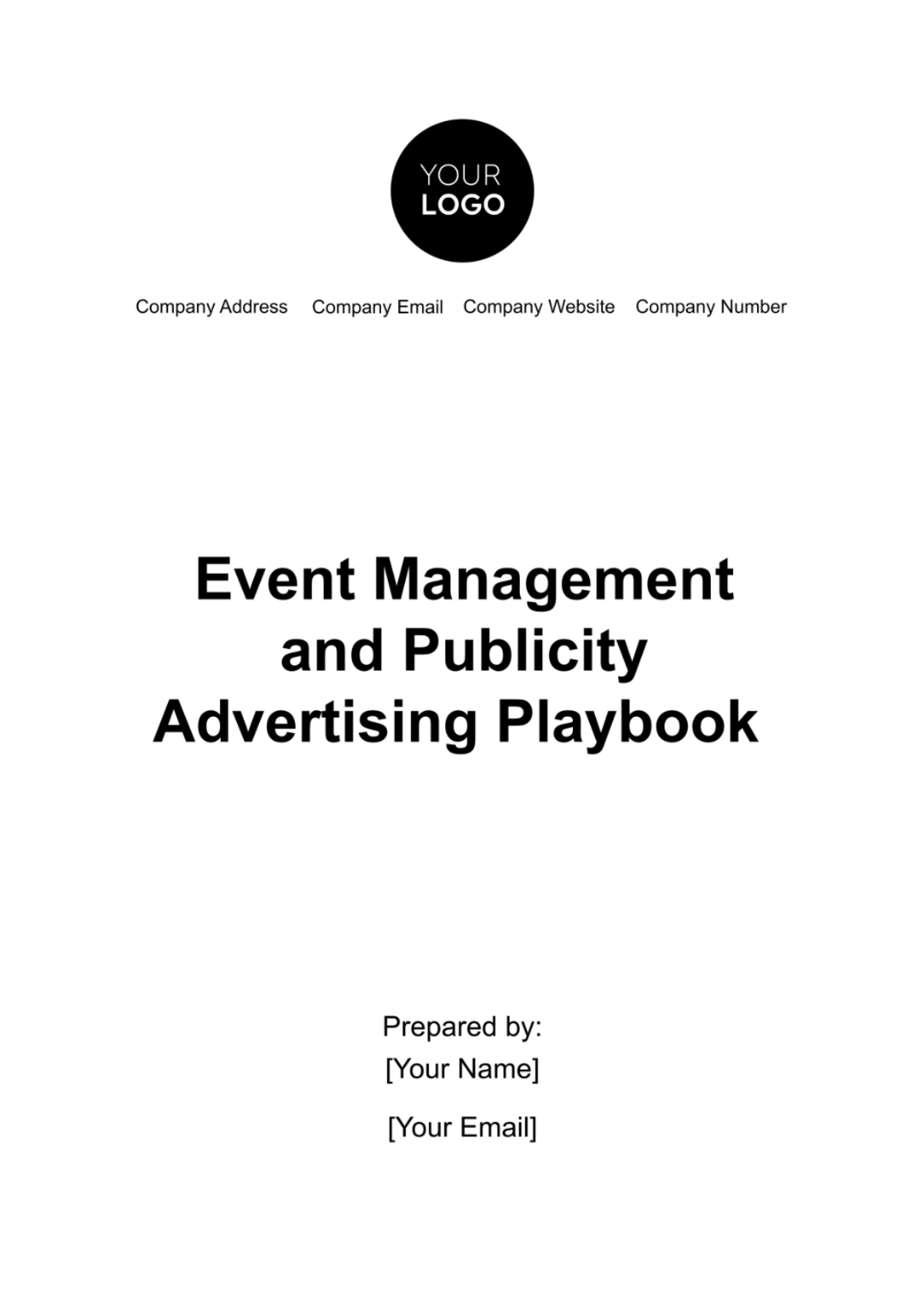
Introduction
Business Objectives:
[Your Company Name] is poised to achieve multifaceted business objectives. Our primary goal is to elevate brand awareness by [30%], solidifying our presence in the competitive advertising market. To complement this, we have set a substantial [20%] boost in sales through meticulously planned events as a measurable target. Additionally, we aim to position [Your Company Name] as an innovative advertising company, emphasizing a commitment to both tradition and contemporary aesthetics.
Market Expansion:
A crucial addition to our business objectives is the strategic expansion into new markets. [Your Company Name] is committed to identifying and tapping into emerging markets for advertising enthusiasts. By varying our geographical reach, we aim to not only increase sales but also introduce our brand to culturally diverse audiences. This expansion initiative aligns seamlessly with our overarching business goals, ensuring sustained growth and relevance in the ever-evolving advertising industry.
Event Objectives:
The events hosted by [Your Company Name] in [2050] are designed with precision to achieve specific objectives that align seamlessly with our overarching business goals. Foremost among these is the execution of a flagship product launch event, meticulously crafted to showcase our latest advertising collections. This event is not merely a platform for product presentation but a strategic move to foster direct connections with our target audience.
Beyond this, the facilitation of networking opportunities with key industry influencers and potential clients is paramount. We have anticipated the ripple effect of these connections to extend far beyond the event, contributing significantly to our sales and brand visibility. Furthermore, a key event objective is to generate a substantial social media buzz, intending to reach an impressive [1 million] impressions. This metric underscores our commitment to leveraging digital platforms for maximum reach and engagement.
Target Audience
Primary Audience:
Our primary focus is on understanding and captivating the attention of specific segments that are integral to the success of [Your Company Name]. By tailoring our events and advertising efforts to resonate with their creative sensibilities, we aim to establish [Your Company Name] as their go-to source for exquisite advertisements. Additionally, individuals who are passionate about creating aesthetically pleasing advertisement spaces. Our strategy involves creating compelling content that sparks their imagination and positions [Your Company Name] as a brand that understands and fulfills their desires.
Lastly, retailers and distributors play a pivotal role in expanding our market reach. Building strong relationships with this segment is imperative for the seamless distribution of our products. By identifying and addressing the unique needs of these primary audiences, [Your Company Name] is poised for sustained success in [2050].
Secondary Audience:
While our primary focus is on industry professionals and enthusiasts, we recognize the importance of engaging a broader audience to amplify our brand impact. Media and influencers are key players in shaping public perception, and strategic collaborations with them can significantly elevate [Your Company Name]'s visibility. Social media holds immense sway, their endorsements and coverage can extend our reach far beyond traditional marketing channels.
Additionally, the general consumer demographic remains a secondary but essential audience. Crafting messaging that resonates with this group ensures that [Your Company Name] remains top-of-mind. In summary, our approach to the target audience is dynamic, recognizing the distinct needs and influences that shape both industry insiders and the broader consumer base.
Emerging Markets:
A strategic addition to our target audience considerations is the identification and cultivation of emerging markets. [Your Company Name] is committed to understanding and tapping into new geographical areas where the demand for innovative advertising companies is on the rise. This proactive approach aligns seamlessly with our growth objectives and ensures that [Your Company Name] remains ahead of industry trends by establishing a presence in markets poised for expansion. The incorporation of this subsection reflects our commitment to not only meet the needs of our existing audience but also anticipate and cater to the demands of emerging markets in the advertising industry.
Event Planning
Event Concept:
The conceptualization of our event in [2050] is a meticulous process centered around unveiling the [Event Name] theme. This theme is not merely a decorative choice but a strategic narrative that encapsulates the essence of [Your Company Name]. By emphasizing the fusion of tradition and innovation in advertising, we aim to position our brand as a transformative force in the industry.
The [Event Name] theme serves as a powerful storytelling tool, engaging attendees on a deeper level and inviting them to witness firsthand the evolution of our craft. The active integration of this theme into every aspect of the event ensures a cohesive and immersive experience for our audience.
Venue Selection:
The chosen venue, centrally located and visually appealing, acts as a physical manifestation of [Your Company Name]'s brand identity. It serves as the canvas on which our [Event Name] theme will unfold, capturing the attention of attendees and creating a memorable backdrop for product launches and interactive sessions.
This active approach to venue selection ensures that every element, from the architecture to the ambiance, aligns seamlessly with our brand narrative, contributing to a holistic and immersive event experience.
Event Schedule:
The event schedule is a carefully curated timeline that maximizes engagement and impact. We have designed the one-day format to maintain a sense of urgency and exclusivity, driving attendee participation from start to finish. Each segment of the schedule, from product launches to live demonstrations and interactive sessions, serves a strategic purpose in reinforcing our brand message and fostering direct connections with our audience.
The active planning of a diverse and dynamic schedule ensures that attendees experience a comprehensive overview of [Your Company Name]'s offerings, leaving them inspired and eager to engage with our brand beyond the event.
Publicity Advertising Strategy
Pre-Event Publicity:
The pre-event publicity strategy for [Your Company Name]'s advertising showcase is a dynamic and engaging process designed to build anticipation and excitement. Through carefully crafted teaser campaigns on social media platforms, we actively capture the curiosity of our audience. Utilizing visually appealing content, countdowns, and sneak peeks, we create a sense of exclusivity around the event
Collaborations with key influencers are a pivotal element of our strategy, leveraging their reach and credibility to amplify our message. The active involvement of influencers ensures that our target audience receives personalized and authentic endorsements, generating heightened interest in the upcoming advertising showcase. This strategic pre-event publicity sets the stage for a successful event launch and positions [Your Company Name] at the forefront of industry conversations.
During Event Advertising:
The advertising strategy during the event is an immersive experience that actively engages both physical and virtual attendees. Leveraging the power of live-streaming on social media platforms, we bring the event to a global audience in real time. This active approach allows us to showcase product launches, live demonstrations, and interactive displays to a diverse and expansive viewer base.
Additionally, we incorporate augmented reality experiences into our advertising strategy, providing attendees with a cutting-edge and interactive way to explore our advertising collections. By actively embracing digital platforms and innovative technologies during the event, we ensure that [Your Company Name] stands out in a crowded market, leaving a lasting impression on both in-person and virtual attendees.
Post-Event Publicity:
The post-event publicity strategy is a continuation of our active engagement with the audience, extending the lifespan of the event's impact. We actively release a professionally crafted event highlights video on prominent video-sharing platforms like YouTube. This video encapsulates the key moments, product launches, and the overall atmosphere of the event, serving as a shareable and visually compelling recap.
Simultaneously, we leverage the post-event period to launch limited-edition advertisements. This active post-event strategy not only sustains the momentum generated during the event but also capitalizes on the heightened interest and enthusiasm of our audience. By strategically combining video content and exclusive product releases, [Your Company Name] ensures a prolonged and impactful presence in the post-event landscape.
Marketing Channels
Social Media:
The social media strategy is an active and strategic approach to leverage the immense reach and influence of platforms such as Instagram, Facebook, and Twitter. Engaging in real-time conversations and updates, we actively utilize these channels to disseminate compelling content that aligns with the [Event Name] theme. Through visually appealing posts, interactive stories, and live updates, we actively maintain an ongoing dialogue with our audience.
Influencers play a crucial role in our social media strategy, as we actively collaborate with them to extend our reach and tap into their dedicated follower base. By actively participating in the social media landscape, we ensure that [Your Company Name] remains at the forefront of industry conversations and stays top-of-mind for our target audience.
Traditional Media:
Press releases serve as a powerful tool for disseminating official statements and key information to leading home decor magazines and newspapers. We actively cultivate media partnerships, ensuring prominent coverage in influential publications. By actively engaging with traditional media, we aim to reach a broader audience that may not be as active on digital platforms. This active inclusion in traditional media outlets solidifies [Your Company Name]'s credibility and presence in both digital and print, creating a comprehensive and far-reaching marketing strategy.
Budget and Resources
Budget Allocation:
The strategic allocation of the budget for [Your Company Name]'s events is a meticulous process that actively aligns financial resources with key priorities. We allocate funds with precision, ensuring that each aspect of the event, from venue rental and decor to catering, advertising, and influencer collaborations, receives the necessary financial backing.
This active approach involves a careful balance between cost-effectiveness and impactful investments, guaranteeing that every dollar spent contributes directly to the achievement of our business and event objectives. By actively managing the budget allocation, we position [Your Company Name] to execute a seamless and memorable event that maximizes return on investment.
Team and Partnerships:
Assembling a dedicated events team and forging strategic partnerships are active steps in ensuring the success of [Your Company Name]'s events. The events team is actively selected based on expertise, creativity, and a proven track record in executing successful campaigns. Their active involvement ensures that every aspect of the event, from planning to execution, is handled with precision and creativity. Additionally, strategic partnerships with event management professionals actively complement our in-house team's capabilities. By actively collaborating with external experts, we tap into a wealth of experience and resources, ensuring a comprehensive and well-executed event.
Measurement and Analysis
Key Performance Indicators (KPIs):
Establishing key performance indicators (KPIs) is an active and crucial component of our strategy to measure the success of [Your Company Name]'s events. We actively track social media impressions, website traffic, and sales conversion rates to quantitatively assess the impact of our advertising campaigns. By setting clear and measurable KPIs, we ensure that our objectives, both in terms of brand awareness and sales, are actively monitored throughout and after the event. This active monitoring allows us to make real-time adjustments to our strategy, optimizing for maximum effectiveness and ensuring that we actively meet and exceed our established benchmarks.
Data Analysis:
The active analysis of data is a continuous and dynamic process that underpins our approach to evaluating the success of our events. Leveraging advanced analytics tools, we actively interpret data on attendee engagement, social media interactions, and website behavior. This active analysis provides valuable insights into audience preferences, allowing us to tailor future events and advertising efforts to better resonate with our target demographic. By actively applying a data-driven approach, [Your Company Name] remains agile and responsive, using actionable insights to refine strategies, enhance audience engagement, and ultimately achieve sustained growth.
Continuous Improvement Strategies
Post-Event Evaluation:
We have ingrained the active pursuit of continuous improvement in our strategy, with a dedicated focus on post-event evaluation. Following each event, we conduct a thorough assessment to actively review successes, challenges, and areas for improvement. By actively gathering feedback from attendees, analyzing post-event data, and conducting internal team debriefs, we gain valuable insights into the event's overall effectiveness. This active evaluation not only informs future event planning but also ensures that [Your Company Name] is adaptable and responsive to evolving market dynamics.
Iterative Event Planning:
Based on insights gained from post-event evaluations and evolving market trends, we actively refine and enhance our event strategies. This active iteration involves revisiting event concepts, adjusting advertising strategies, and fine-tuning execution plans. By actively learning from each event and applying these learnings to subsequent endeavors, [Your Company Name] remains at the forefront of innovation in the advertising industry.
Industry Trend Monitoring:
To actively stay ahead of the curve, we incorporate continuous monitoring of industry trends into our strategic framework. By actively tracking shifts in consumer preferences, emerging design trends, and advancements in technology, we proactively adapt our offerings and marketing strategies. This active approach positions [Your Company Name] as a trendsetter, ensuring that our advertising and events remain contemporary and in demand. Through regular industry trend analysis, we actively anticipate market changes and actively position ourselves as a leader in the ever-evolving advertising business.
Conclusion:
This playbook serves as a roadmap for executing a successful event and publicity advertising campaign in [2050] for [Your Company Name]. By focusing on strategic planning, engaging content, and data-driven analysis, we aim to position our advertising business at the forefront of the industry, ensuring sustained growth and brand recognition.
- 100% Customizable, free editor
- Access 1 Million+ Templates, photo’s & graphics
- Download or share as a template
- Click and replace photos, graphics, text, backgrounds
- Resize, crop, AI write & more
- Access advanced editor
Achieve event success with Template.net's Event Management and Publicity Advertising Playbook Template. Seamlessly plan and promote events with this user-friendly guide, covering logistics to publicity strategies. Ensure a flawless event experience with this comprehensive playbook. Elevate your event management with Template.net's playbook template!
You may also like
- Event Flyer
- Event Presentation
- Event Poster
- Event Planner
- Event Letter
- Event Program
- Event Invitation
- Event Ticket
- Event Proposal
- Plan Event
- Event Banner
- Event Calendar
- Event Checklist
- Event Schedule
- Event Brochure
- Event Planning Contract
- Event ID Card
- Event Menu
- Event Report
- Event Agreement
- Event Form
- Event Postcard
- Event Quotation
- Event Budget
- Event Sheet
- Event Logo
- Event Planner Business Card
- Event FlowChart

